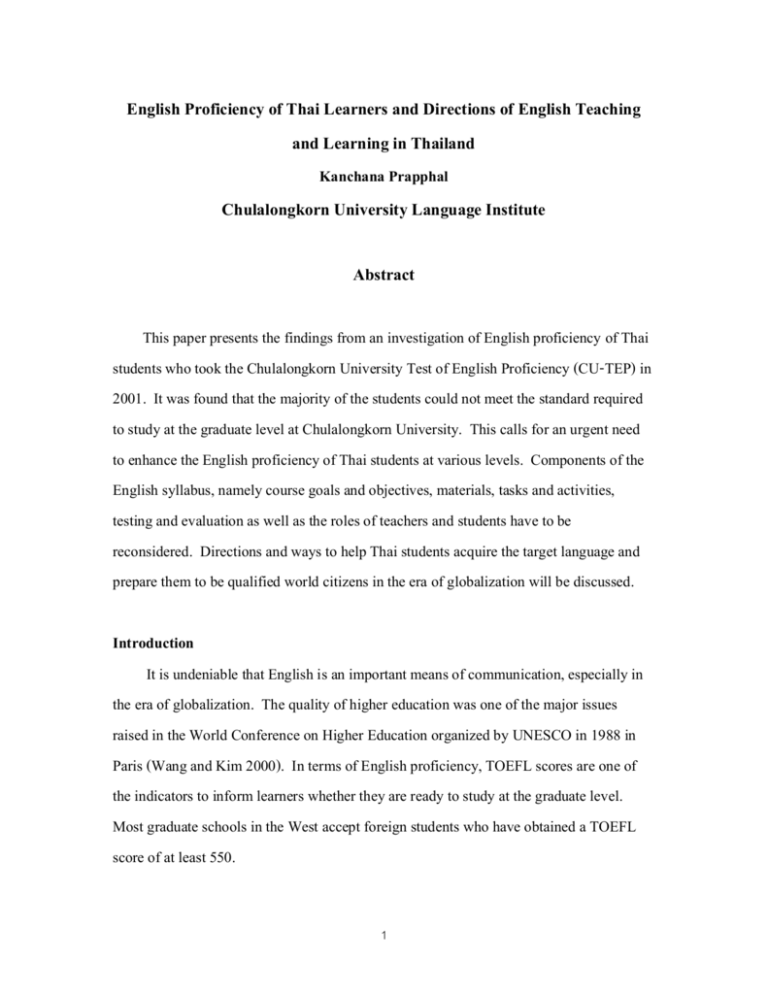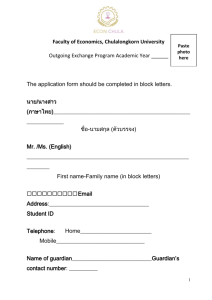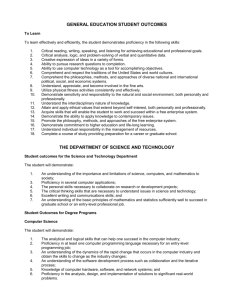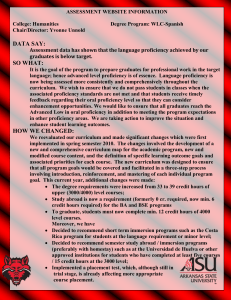English Proficiency of Thai Learners and Directions of English
advertisement

English Proficiency of Thai Learners and Directions of English Teaching and Learning in Thailand Kanchana Prapphal Chulalongkorn University Language Institute Abstract This paper presents the findings from an investigation of English proficiency of Thai students who took the Chulalongkorn University Test of English Proficiency (CU-TEP) in 2001. It was found that the majority of the students could not meet the standard required to study at the graduate level at Chulalongkorn University. This calls for an urgent need to enhance the English proficiency of Thai students at various levels. Components of the English syllabus, namely course goals and objectives, materials, tasks and activities, testing and evaluation as well as the roles of teachers and students have to be reconsidered. Directions and ways to help Thai students acquire the target language and prepare them to be qualified world citizens in the era of globalization will be discussed. Introduction It is undeniable that English is an important means of communication, especially in the era of globalization. The quality of higher education was one of the major issues raised in the World Conference on Higher Education organized by UNESCO in 1988 in Paris (Wang and Kim 2000). In terms of English proficiency, TOEFL scores are one of the indicators to inform learners whether they are ready to study at the graduate level. Most graduate schools in the West accept foreign students who have obtained a TOEFL score of at least 550. 1 The Graduate School of Chulalongkorn University has realized the importance of English because it can help students to acquire knowledge from all over the world. Therefore, it is a requirement that all students who apply for the Graduate School at Chulalongkorn University have to take the Chulalongkorn University Test of English Proficiency (CU-TEP) before being admitted. One of the missions of the Academic Testing Center of Chulalongkorn University (CU-ATC) is to administer the CU-TEP to all applicants. The test has been developed to be a general proficiency test of English to measure listening, reading, and writing skills. Not only do we want to measure the students’ abilities, but we also would like to know how well our tests can discriminate the examinees. This has led us to conduct a research survey. The Study Research Questions This study aims to answer these two research questions: 1. What is the general proficiency of Thai graduates who obtained their Bachelor’s degrees from local universities? 2. What is the general proficiency of graduates from ASEAN? Scope of the Study The subjects were those who took the CU-TEP in order to attend the Graduate School of Chulalongkorn University in 2001. The graduates from ASEAN were those who took TOEFL between 1993-1999 except for the year 1997-1998 as reported by the Educational Testing Service (ETS). The CU-TEP is an objective test in multiple choice format. Subjects There were 9,154 subjects consisting of 3,188 science students, 5,808 social science and humanities students, and 158 students who wanted to attend international programs at Chula. As for the graduates from ASEAN, there were 377,947 subjects: 2 1,153 were Cambodians, 77,353 were Indonesians, 752 were Laotians, 62,695 were Malaysians, 17,230 were Filipinos, 5,844 were Singaporeans, 15,999 were Vietnamese, 3,945 were Burmese, and 183,822 were Thais. Instrument The instrument used in this study is the CU-TEP which is an English proficiency test developed by Chulalongkorn University to assess the students' ability to use English in an academic context. It consists of three parts: PART I : Listening Comprehension (30 points) PART II : Reading Comprehension (60 points) PART III: Writing (30 points) All test items are in the multiple-choice format. The contents of the test materials are general English drawn from different registers. The skills and abilities measured are appropriate for higher education. Validation Each CU-TEP was piloted before being administered. Its contents have been edited and approved by content specialists in English testing. The reliability coefficients of the tests range from .861 to .907 (KR-20). As for concurrent validity, CU-TEP has been equated with the Test of English as a Foreign Language (TOEFL) and the correlation coefficient is considered high (r > .80). In addition, the test results can predict success in academic English at the graduate level. The Use of CU-TEP The result of each skill is individually reported. The TOEFL equated score of 500 is required for admission to Ph.D. programs and 550 or 600 for international programs at the Graduate School of Chulalongkorn University. Other local institutions have been 3 using CU-TEP for screening, placement and admissions. The cut-off scores depend on the objectives of each program. Data Collection The Thai graduates took the CU-TEP between January 7, 2001-March 4, 2001. The test administration followed the standardized procedure. Data Analysis Percentages and average means were used in this study. Results Table 1 illustrates the TOEFL mean scores and ranks of students from ASEAN and Thai students who took the CU-TEP. 4 Table 1 TOEFL Mean Scores and Ranks of Students Types of Students Average TOEFL Scores Cambodians 505 Indonesians 518 Laotians 496 Malaysians 527 Filipinos 578 Singaporeans 596 Thais 498 Vietnamese 511 Burmese 512 Science students 450* Social Science and 444* Humanities students International program 489* students Rank 7 4 9 3 2 1 8 6 5 11 12 10 *Scores from the CU-TEP which have been equated with TOEFL scores The results indicate that the average English proficiency of Thai students is lower than that of students from other ASEAN countries. Science students scored an average of 450 while social science and humanities students scored an average of 444. The students who wanted to study in international programs scored higher than the first two. However, their scores are still lower than those who took the TOEFL. As for ASEAN, Singaporean graduates rank first with an average score of 596 while Laotian graduates rank last with an 5 average score of 496. On average, the students who can attend colleges in the West without taking any English courses are those from Singapore and the Philippines. One explanation is that the ones who took the TOEFL may have had special training in taking the test. Another reason may be due to the affective factor. ASEAN students might be highly motivated because they wanted to study abroad. It is quite clear that the students from English speaking countries scored higher than those who studied English as a foreign language. Exposure to the target language and high motivation may be key factors to enhance the English proficiency of the students. Proficiency in listening, writing and reading of the graduates from local universities are further examined. Table 2 illustrates the percentages and ranks of the studied skills. Table 2 Percentages and Ranks of Listening, Writing and Reading Skills of Graduates from Local Universities Type and Number 1. Science (3,188) 2. Non-science (5,808) 3. International programs (158) Listening Writing Reading % Rank % Rank % Rank 32.95 3 37.10 2 39.20 1 31.57 3 36.00 2 36.85 1 49.02 1 47.79 2 44.27 3 As for science graduates, reading skills excel their writing and listening skills. Similarly, non-science graduates do best on reading and worst on listening. Their writing skills are quite close to their reading skills. The graduates who want to study in international programs do best on listening, followed by writing and reading respectively. 6 The results suggest that the students should practice all three skills more. However, the emphasis depends on the needs of each individual. Directions and ways to enhance their English skills will be discussed in the following part. Directions and Ways to Enhance English Proficiency Due to the limited number of English teachers in Thailand, we, language teachers, have to find new ways to help our students to achieve their goals. A Chapter in the Educational Reform Act states that Thai learners should have global literacy. That is, they must know English, be able to use the Internet, and understand cultures of other countries to be qualified as world citizens. For higher education, they should be able to exchange knowledge, have interactive networking, and collaborate in international research projects (UNESCO). From the stakeholders’ point of view, they expect to have graduates who have communication skills in English and Thai. Wongboonsin et al. (2003) report the following desirable skills, competencies, and qualifications suggested by stakeholders, academicians, and specialists in human resource development. " a. Skills: Thai learners should be equipped with conceptual skills, operating skills, technical skills, management skills, human skills, and communication skills. b. Competencies: They should have English proficiency, computer literacy, analytical ability, innovation, and critical thinking. c. Qualifications: They must meet international standards, adopt the attitudes of life-long learning, and have positive attitudes towards learning and working. In addition, they should be able to work in a team." In the competitive global arena, computer literacy appears to be one of the top requirements as Panitchapakdi (1998) mentioned. 7 “We need to have a workforce whose members are innovative and creative. We can no longer afford to benefit from cheap labor, especially in the future when competitiveness will be determined on technological capabilities.” Therefore, to help students become equipped with the skills that both academic and business sectors require, English teaching and learning at various levels needs to be reconsidered. English skills, computer skills and knowledge of cultures need to be integrated into language courses. Tasks and activities must be designed to expose the students to the target language and increase their motivation to learn the language in class and acquire the language outside class. It has been suggested that the following are key components in a course syllabus. 1. Goals and objectives 2. Materials 3. Methods of teaching 4. Testing and Evaluation 1. Goals and Objectives Short (2003) proposes the following ESL goals for Pre-K-12 students. Goal 1: To use English to communicate in social settings. Goal 2: To use English to achieve academically in all content areas. Goal 3: To use English in socially and culturally appropriate ways. In the Thai context, local needs as well as regional and global needs should be assessed in order to set the goals and objectives of English teaching at various levels. The information should be drawn from teachers, administrators, students, stakeholders and other parties concerned. 8 2. Materials Materials should be prepared based on a needs analysis which corresponds with the stated goals and objectives. Teaching materials as well as learning materials which contain various tasks and activities should be employed. The tasks should incorporate English skills, computer skills as well as cultural knowledge. Different types of materials such as texts, newspapers, tapes, CD- ROM , ETV, Internet should be used where appropriate to encourage both learning and acquisition in the classroom and outside the classroom. Following are some useful web sites for English teaching and learning. http://nationmultimedia.com/edu/ http://www.student-weekly.com/ http://iteslj.org/links 3. Methods of Teaching Language teachers have to change their roles and equip themselves with modern technologies. Teachers can supplement their teaching by using IT tasks such as CALL activities, E-mail writing tasks, web-based projects, on-line self-tests and electronic portfolios. Choosing appropriate tasks for students, teachers can enhance their students' general proficiency as well as achieve the desirable goals and objectives. However, they should bear in mind that 1. Technology cannot substitute for a good language teacher but it can supplement and facilitate our teaching. 2. Our responsibility is to help students communicate and realize that they are part of the "global village." In addition, the roles of the teacher and learner will change. The teachers have to act as teachers, facilitators, mentors, as well as assessors and evaluators, whereas the students have to be learners, collaborators, problem solvers, thinkers, as well as assessors and evaluators. Different methods using IT such as Intranet pedagogy and Internet pedagogy like web-based teaching, distance education and virtual classrooms may be 9 adopted when there is a lack of language teachers. (See Prapphal 1997, 1998, and 2001 for more details.) 4. Testing and Evaluation Both proficiency tests and achievement tests should be used in the curriculum. The former indicate the general proficiency of the students while the latter show the mastery of the course objectives. To compare the ability of the students with the international norm, proficiency tests are more appropriate. On the other hand, achievement tests which reflect the real-life performance of the students in language courses are needed. Test scores and performance profiles are also important indicators for teaching accountability. Conclusion This paper presents the results from a study on English proficiency of Thai students. On average, graduates from local universities in Thailand need more practice in listening, writing, and reading skills. When compared with an international standard, in this case, TOEFL scores, most graduates from science and non-science fields are not ready to be admitted to study at the graduate level in western colleges. Directions and ways to enhance English proficiency of Thai students have been proposed in this paper. Desirable skills, competencies, and qualifications demanded by stakeholders have to be taken into consideration when planning a language syllabus. In addition, English skills, computer skills and knowledge of cultures need to be integrated into language courses if language teachers want to prepare their students to be able to communicate with their global peers. 10 References Panitchapakdi, S. 1998. "Keynote Speech." The 1998 International Symposium on "The Central Intellectual Property and International Trade Court as a Model for IPRs Enforcement for the 21st Century" in Bangkok on 22 January 1998. Prapphal, K. 1997. Educational technology for TEFL. PASAA, 27, December 1997, 121127. Prapphal, K. 1998. Self-directed learning through the Internet and Intranet pedagogy: a choice for language teachers. PASAA, 28, December 1998, 62-82. Prapphal, K. 2001. Globalization through distance education via Inter- and Intranet pedagogy. PASAA, 31, July 2001, 75-81. Prapphal, K. and Opanon-amata, P. 2002. An investigation of English proficiency of Thai graduates. Research Report. Chulavijai, 21(3), 12-16. Short, D. 2003. http://www.cal.org/ericcll/digest/0013ESL TOEFL Test and Score Data Summary, ETS (1993-1999). Wang, Y. and Kim, C-H. 2000. "Quality assurance, credit transfer and mutual recognition in higher education--Role on Quality Assurance in Higher Education: Standard, Mechanisms and Mutual Recognition. Bangkok, Thailand, 8-10 November 2000. Wongboonsin, K. et al. 2003. A study on the future of Thai workforce. Sor Kor Wor Foundation. 11




